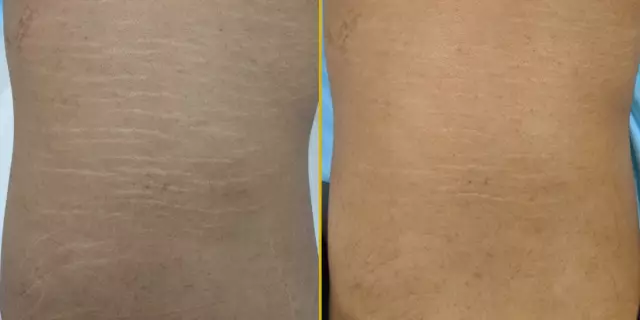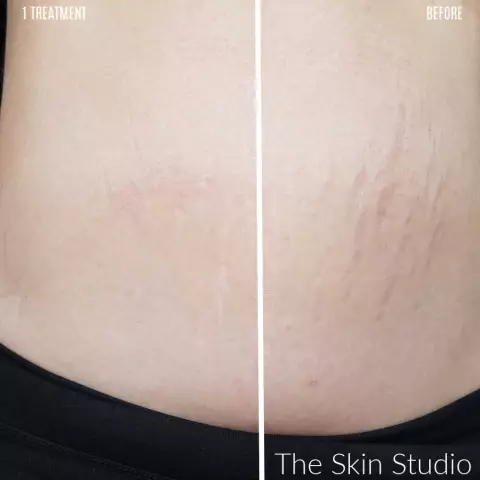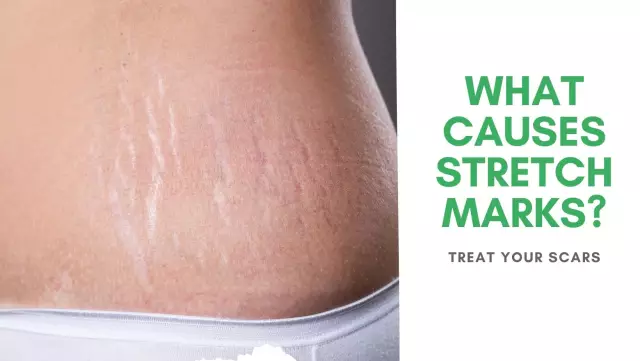- Author Rachel Wainwright [email protected].
- Public 2023-12-15 07:39.
- Last modified 2025-11-02 20:14.
6 myths about stretch marks
Stretch marks (stretch marks) are skin defects in the form of straight or wavy stripes 1-10 cm long and 1-5 mm wide. In most women, striae are located on the abdomen, thighs, breasts, or buttocks. In athletes, they can appear on the shoulders and inner surface of the forearms. At the initial stages of formation, stretch marks have a red or lilac color, but over time their color fades, the stripes become whitish, acquire a pearlescent hue.
Stretch marks occur as a result of microtraumas of the inner layers of the skin and subcutaneous tissue. They do not pose a health hazard, but are considered a serious defect in appearance.
There are a number of cosmetic treatments available to combat stretch marks. These methods do not completely eradicate them, but they help to make the streaks on the skin less visible. Specialists, as a rule, successfully cope with this task. Despite this, many women continue to believe the myths about stretch marks and try to fix the problem on their own, which usually does not bring tangible benefits. In this article, we will try to comment on the most common misconceptions about striae.

Source: depositphotos.com
Stretch marks occur due to poor skin condition
The main reason for the appearance of stretch marks is changes in the condition of the skin associated with fluctuations in the hormonal background (an excess of sex hormones, adrenal hormones and thyroid gland). Striae may indicate the presence of the following pathologies:
- hypercortisolism (including youth);
- Marfan syndrome;
- Itsenko-Cushing's syndrome;
- adrenal hyperplasia;
- diencephalic syndrome.
In addition to hormonal imbalance, one of the main factors in the appearance of stretch marks is too rapid stretching of the skin. That is why they develop in most expectant mothers during the period of gestation, in athletes who take hormones during intense training, as well as in children and adolescents who are prone to rapid weight gain due to hormonal problems. It is not at all necessary for a person to suffer from skin diseases.
Stretch marks can be prevented
In the presence of a hereditary predisposition, it is impossible to completely avoid the appearance of striae. However, people at risk (pregnant women, adolescents, patients with hormonal dysfunctions and tendency to obesity, etc.) can minimize the risk of developing stretch marks. For this, it is necessary to regularly carry out procedures that help strengthen the skin and increase its elasticity.
At home, the easiest way is to take a contrast shower every day, massage problem areas with a hard washcloth, and then apply cosmetic products to the skin that have a moisturizing and nourishing effect. Treatment with essential oils is considered very useful. However, one should not forget that such funds can provoke allergic reactions, so when selecting them, it is necessary to take into account the factor of individual tolerance.
Striae are easy to remove
Removing stretch marks is very difficult. The success of treatment largely depends on the time of its beginning: the earlier the patient seeks qualified help, the higher the probability of solving the problem.
Young are considered striae that appeared no more than six months ago and have not yet changed their original color. Removing old (whitened) stretch marks requires radical methods, including surgery.
Laser resurfacing is the easiest way to get rid of stretch marks
This is not true. The effect of laser-based procedures is usually exaggerated, and the possible harm to health is tried to be ignored. Even the fact that laser skin resurfacing requires the use of local anesthesia already indicates the complexity of treatment and the presence of contraindications.
There are other types of salon impact on problem areas:
- seaweed wrap. It is used to remove relatively small, recent stretch marks. The cosmetic effect is noticeable after 6-12 procedures;
- photopigmentation. The method is absolutely safe and less traumatic. The result is the activation of natural collagen production and skin cell regeneration;
- microdermabrasion. The procedure is the grinding of problem areas using a jet of air saturated with fine grains of sand. Optimizes blood supply to tissues, makes the top layer of the skin smooth;
- enzyme injections. The method is very effective - stretch marks practically disappear. Unfortunately, the effect of enzymes is short-lived, and in 2-3 years after the procedure, cosmetic defects appear again;
- abdominoplasty. Surgical intervention, consisting in the radical removal of damaged areas of the skin on the abdomen along with the subcutaneous fatty tissue.
At home, self-massage is usually used to combat stretch marks, as well as various masks, compresses and scrubs made from natural ingredients. The most popular products are coffee, yoghurt, milk, herbal decoctions, aloe juice, essential oils of rosemary, almond and orange, sugar, table salt, mummy, bee products, and cosmetic clay.
Each of the described methods can have side effects. The success of treatment directly depends on the characteristics of the patient, therefore, the method of dealing with stretch marks should be selected individually.
The likelihood of striae is associated with complexion
There is no direct link between the risk of stretch marks and complexion: in overweight and thin pregnant women, they appear with the same frequency.
However, with painful thinness, thinning of the subcutaneous layer of adipose tissue is quite possible, and the presence of excess weight can be a sign of hormonal imbalance. In both cases, the risk of developing stretch marks increases.
Men don't have stretch marks
Many consider striae to be an exclusively female problem. This is not true. Stretch marks can appear in boys and girls who are prone to being overweight during puberty. Athletes - both men and women - also face this trouble when they resort to taking hormonal drugs in an effort to quickly build muscle mass.

Source: depositphotos.com
The solution to the problem of stretch marks must be approached reasonably and competently. Given the prevalence of this trouble, it is required to regularly carry out preventive procedures at home in order to reduce the risk of stretch marks formation. If they appear, you need to contact an experienced cosmetologist as soon as possible and follow his advice. In this case, it is possible to make the cosmetic defect we are considering almost invisible.
YouTube video related to the article:

Maria Kulkes Medical journalist About the author
Education: First Moscow State Medical University named after I. M. Sechenov, specialty "General Medicine".
Found a mistake in the text? Select it and press Ctrl + Enter.






